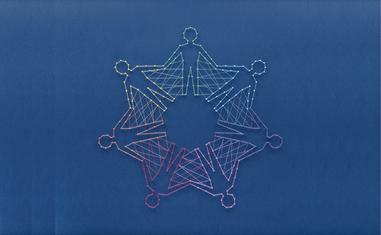The views expressed in our content reflect individual perspectives and do not represent the authoritative views of the Baha'i Faith.
Rather than the movement of all things being apparent randomness, numerous ways of knowing have found a deep order to the wholeness-in-motion around us and within us.
That movement maintains an overall balance and harmony in all things.
Imagine all things in the entire Creation making up one interconnected whole. In this wholeness, everything is so interdependent that apparent opposites – like yin and yang, feminine and masculine – become complementary, interrelated halves of the same whole, balancing, integrating, uniting, and transcending their assumed duality.
RELATED: Only Human Unity, on a Spiritual Level, Can Assure Our Survival
This is the wholeness that many mystic traditions and mindfulness practices seek, a state of consciousness central to Indigenous wisdom traditions and a unifying field of awareness available to all.
A vision of this wholeness is found in the Hermetic principle of “As above, so below; all things accomplishing the miracles of the One Thing.”
This is also the vision that Plato offered us: “Perhaps there is a pattern set up in the heavens for one who desires to see it, and having seen it, to find one in himself.”
An even clearer way to express this truth comes from Abdu’l-Baha: “The evolution of existence is one. The divine order is one. All things great and small are subject to one law and one order.”
This deep order to the movement of all things was confirmed by science in the 1950s when David Bohm identified the holomovement, or the single energy that maintains the balance, harmony, and unity of the undivided wholeness in the entire cosmos.
The “one order” and “one law” upon which all things find their existence, movement, and direction is central to many ways of knowing. This holistic law of correspondence between the macrocosm and the microcosm has formed the pattern designed to maintain our inherent wholeness.
Patterns allow us find meaning in all things, especially when they connect apparent randomness. The earliest Indigenous peoples observed patterns in nature that gave them wisdom to live by. They closely viewed the cycles of nature and applied these insights to their own lives.
Built-in to their rites of passage was a process of transformation that Arnold van Gennep identified as the pattern taking the initiate to the next stage of life through the three phases of separation, transition, and incorporation.
Transformation is at the core of this pattern, which keeps us moving along a path intended to guide us from separation to union or wholeness. This central pattern is also found within the basic structure of story itself. It is not just beginning, middle, and end, but on a deeper and more meaningful level beginning, muddle, and resolution. The muddles, or challenges we face, represent the core of the pattern bringing the process of transformation to its completion, or resolution.
This hidden thread of wholeness connecting us all also runs deep in the mysticism of all sacred traditions. Around 1900, Evelyn Underhill described “the mystic way” as a journey of spiritual transformation following a pattern that leads from awakening to purification to union.
Some 50 years later, in mythology, another version of this pattern was made popular by Joseph Campbell who pulled together the archetypes of the world’s myths to form the pattern he called the monomyth, consisting of a journey of departure, initiation, and return.
This pattern of living into wholeness also finds its way into the psychology of Carl Jung. He called this the “individuation process” which consists of the conscious experience of the archetypes we are born with, embedded in our psyche, or unconscious, bubbling up from within, released by life experiences, making us aware of their innate existence, and enabling the merging of opposites into a new whole. This involves great struggle and takes in the stages of birth of the ego, death of the ego, and birth of the whole self.
RELATED: Caroline Simpson: Early Baha’i Advocate of Interracial Unity
What we end up with when we merge these practices and ways of knowing is a blueprint for living into wholeness, which brings with it a unitive consciousness. This blueprint consists of three main parts: Call to Wholeness, Path of Purification, and Return to Wholeness.
This pattern, essential to our spiritual DNA, transforms our lives, allows us to focus on the wholeness of all things, and keeps humanity on its evolutionary path, all at the same time.
We become aware of this universal pattern as we communicate more with the inner realm and as the eternal bursts forth from our unconscious, giving us a timeless understanding that countless others have experienced before us. When this happens, this universal pattern becomes a roadmap for achieving the greatest expansion of consciousness that is humanly possible. All of these variations on the same pattern exist because of the “one law and one order” governing “the evolution of existence.”
Adapted from A New Story of Wholeness: An Experiential Guide for Connecting the Human Family by Robert Atkinson.

















Comments
Sign in or create an account
Continue with Facebookor